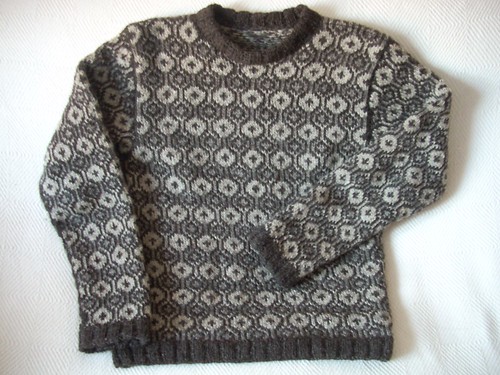Ron asked about the armhole, whether I bind off some stitches at the bottom and then more as I go up. Not quite, but almost: instead of binding them off I put them on a thread. That makes it easy to add them to the stitches I pick up to knit the sleeves - and it's more comfortable too as there's no ridge. On the following rows I did some more decreases, partly for comfort and partly to make it look nice, to avoid amputated repeats, so to speak.
To avoid jogs in the pattern I added narrow side panels: this way all rows start with the same colour, and it is possible to continue the pattern along the sleeve and place the sleeve decreases on each side of it.
Carolina asked if I calculate in detail beforehand to make sure the pattern comes out right. Not really - or not anymore, I should say. Too eager to start knitting I do a rough calculation and then trust a combination of luck and experience!
Jules asked if short-row armscyes would work for an Alice Starmore sweater. I'm sure it would! The tricky thing is doing short rows with two colours, finding the right places for the wraps. There's a risk that light-colour wraps around a dark stitch will show glaringly, so I make sure they're the same colour. It's a pity if the wraps draw attention to themselves instead of being as invisible as possible.
.jpg) |
| shoulder join and sleeve cap |
I've cast on to make a traditional Swedish spedetröja. Traditional in the sense that I use the traditional shape and a common kind of star pattern from the period (late 1800s) but it's not a copy of an existing garment. This sweater is for Anna, who teaches dances from the 1700s. Next lesson is tonight - highlight of the week!
 |
| 2ply wool from Kampes; 2.25 mm needles (US 1) |

.jpg)
.jpg)
19 comments:
Vackert! För att inte säga mästerligt, och färgerna är så fina!
Beautiful!
What a wonderful faroese knit. Just amazing !
Så mycket fina saker man hittar här.. en fröjd för ögat !!
I see this beautiful, thoughtful quickly created sweater and in comparison think of myself lurching along on a knit for my husband week after week and wonder whether I even deserve to think of myself as a "knitter"!
Inspiring indeed! Thank you so much for allow us this peek at your wonderful work!
Nice færø-pattern and I love the narrow sidepatterns.
Have you seen, that all your classes at Fanø is sold out and that you have waitinglists!!?
I was lucky! See you saturday!
Det är sällan jag är mållös, men nu blir jag stum av beundran. Vilken perfektionism i sticket. Oj oj oj. . .
I, too, love the side panels! Good luck with your next project!
Men åhhhhh jag är mållös!!!
Att fixa mönstret så tjusigt utan att ha räknat ut exakt kallas kvalificerad intuition.
beautiful work (as always)!
När jag ser det fina du stickat känner jag mig preveligerad
Att få gå på kurs med dig på Stickstämman i Undersåker
Lovely work - for example the panels that run from the border to the sleeve cuff. I admire how you pay so much attention to detail.
Ron in Mexico
......
I will ask Christel Seyfarth to engage you to Fanø 2014 to talk about, show and teach us about your beautiful, beautiful details and finish.
Wow, it is so beautiful!
Beautiful !!
Beautiful work, especially the join on the shoulders. By the way, that spedetroyer pattern has been found on a wool fragment from the 17th century in a dig near Copenhagen, so it is even more appropriate.
... so beautiful. ... such finesse.
Love it!
Post a Comment